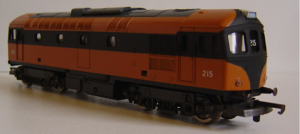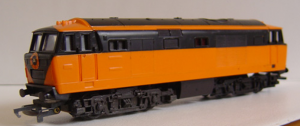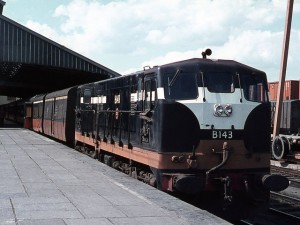Developments in software and digital technology have had wide ranging impacts on our leisure time, from movies on demand on our mobiles, internet on public transport and the ‘selfie’ saturated world of social media. Yet advancements in technology have also reached creative activities that are often considered far from mainstream and groups of individuals, who though they share a common interest, may pursue their leisure activity individually and in relative isolation.
One such social group is that of model railway enthusiasts. For these collectors, builders and hobbyists the developments in software have enabled fundamental changes to the way they explore and express their interests. Geographically dispersed and relatively few in number (estimated in the low hundreds in Ireland) software has offered a means of augmenting the traditional physical locations of interaction, socialising and knowledge sharing. Software and connectivity have enabled a network of online interactions that has linked individuals more closely with the commercial suppliers and the specialist manufacturers of the models they consume, extending the reach of the community beyond the traditional clubs or shows. It has facilitated efficient access to, and the sharing of, previously inaccessible or unknown historic and practical knowledge regarding even the most obscure topics such as window size and seat positions. Building upon more traditional sources of historic data such as printed media and journals, software has also enabled the capture of dispersed and divergent forms of data and facilitated their transformation, via computerised production methods, into ready-to-run models with unprecedented levels of physical detail and functionality.
These models can be seen as a form of preservation of industrial heritage with the sounds and an aesthetic which replicate, in miniature, the authenticated physical form, appropriate to a historical time and place which often no longer exists. This assemblage, which has been verified by formal and informal feedback loops into the social memory of a niche community of enthusiasts, can be seen as transforming a once simple toy into what one company calls ‘museum quality models’.
Originally created from metal such as tin or pewter, the first model trains aimed at the wider market were created in Germany in the late 1800s. Previously models were often steam powered and available only to wealthy collectors but these new models were more affordable being constructed from pressed metal and powered by clockwork mechanisms. Not long after the first real electric locomotive was displayed in 1879, the first electric model train set also appeared on the market produced by the German firm Marklin. Using a three rail system to conduct the power to the motor, these models tended to be relatively large (O Gauge : 7 mm to the foot) with limited levels of detail by modern standards. The German firm Bing, one of the world’s largest pre-war toy producers, introduced a smaller scale, half the size of O Gauge in the 1920s. Firms such as the famous Hornby company in the UK followed suit with the OO scale which appealed to a much wider market for whom space was a practical concern. OO scale and the slightly smaller HO scale which was more popular on the continent, both used the same two-rail system with 16mm between the rails. As production technology improved so gradually did the detailing of the models. In the 1950s the use of plastic was first introduced in model production allowing for cheaper models extending the market still further while simultaneously allowing finer levels of detail through injection moulding rather than reliance on painted representation of smaller parts.
Unlike the UK and US with their larger markets of enthusiasts served by such major brands as Hornby, Bachmann, Walthers etc, collectors of Irish model railways constituted such a small market by international standards that they were rarely supplied with affordable ‘ready to run’ models of the native railway system of the type created through plastic injection moulding. Enthusiasts could only look on with envy at the ever increasing range and quality of models produced in different scales for the foreign larger markets as advertised in the UK and continental model magazines. Occasionally the ‘niche’ Irish market was explored by the larger suppliers. One unusual example was Le Jouet Français (Jouef), a French manufacturer producing very briefly in Co. Clare in the late 1970s when trying to break into the lucrative UK market. As with other examples such as those from Lima (Italian) and Hornby (UK), Joeuf made available to the Irish market prototypes from other national railways which were at best somewhat similar in physical form to rolling stock on the CIE network, painted in recognisable CIE colour schemes or liveries of the time (see Figure 1).
Fig. 1. (from left to right) A Lima British Class 33 locomotive; Af Jouef coach based on a continental, possible French, prototype; A Hornby British Hymec locomotive. All produced in the late 1970s in the CIE livery of the time.
Models were produced in both the popular OO scale (4mm to 1 foot) while continental manufactures used the slightly smaller HO scale (3.5 mm to 1 foot). Both ran on the same track but looked a little odd when mixed. Choice was narrow and the models available were still very much toys which only approximated the actual rolling stock on Irish railways. Serious collectors were limited to scratch building from brass or plastic kits, or using basic materials, as well as ‘model bashing’ models of similar prototypes in order to replicate in miniature the desired Irish prototype. Modellers often worked off personal or archived photographs, drawings and measurements in their attempts to achieve accuracy.
In the last 30 years there have been significant changes in the modelling of railways in general through distributed networks of production and consumption. Firstly there have been major changes and consolidation within the commercial production of models. Hornby bought up brands such as Jouef, LIMA and Rivarossi, all of which had struggled financially having tried to maintain production in Europe. The market became differentiated with an emerging distinction between toy model trains, and the detailed models aimed at collectors for whom higher levels of accuracy was important. Often a manufacturer would have standard and premium product ranges in an attempt to sell into both markets. Production also became centralised through globalisation. The development of Global Production Networks saw major producers transfer production of ready run models to China through the 1990s with the aim of achieving higher levels of detailing while benefiting from significantly lower labour costs. This enabled consumers to purchase levels of quality often previously beyond their price range and setting the bar ever higher as to what base level of detail was acceptable. With recent cost inflation, such cost benefits are fast diminishing.
Secondly, in the last ten years the internet, eCommerce and the Euro changed the way in which models were sold. Online purchasing became possible from specialist suppliers and general retailers including eBay and Amazon with niche model suppliers gaining access to a much wider market. Some traditional mail order firms such as Hattons in Liverpool (UK) become online warehouses with thousands of items in stock at any one time. With software enabled inventory and sales systems replacing traditional paper catalogues and stock lists in magazines, these eCommerce sites also offer detailed descriptions, photographs of stock and sometimes the histories of mainstream and eclectic prototypes. Smaller retailers also added online sales capabilities to their traditional retail outlets with models being sold alongside related specialist DVDs and books dealing with railway history and modelling.
Thirdly hobbyist and collectors , often geographically dispersed, began to avail of software enabled social media such as forums (irishrailwaymodeller.com), photo sharing sites (Flickr.com, www.geograph.ie) as well as personal websites (www.eiretrains.com). Such sites made available personal knowledge and historic data regarding rolling stock design, liveries and composition of trains that previously would have been almost impossible to access without time consuming research through more traditional sources such as the journal of the Railway Preservation Society of Ireland or the National Photographic Archive.
Lastly, software enabled a step-change in the level of detail and accuracy that could be captured within the models themselves. CAD software began to be used to digitise designs from original plans of rolling stock which could be easily updated and augmented before being sent to often distant manufacturers. Computer controlled production and laser etching of moulds more precisely replicated the design information provided to levels that were previously impossible. Production techniques, and the cheaper labour costs enabled the production of intricate details to be added later by hand.
The introduction of a digital control systems for models (Digital Command Control – DCC) also allowed, for the first time, the individual control of a locomotive’s speed, direction, rate of acceleration and lighting both on locomotives and coaches / wagons when sharing the same section of track. Apart from controlling movement and lighting, the technology has more recently been taken to a new level by the introduction of miniaturised sound systems. Linked to the standard control functionality of locomotives, the software encoded chip plays, via a miniature speaker within the model, action-appropriate sounds digitally recorded from real world prototypes (see Fig. 2).
Fig. 2. Miniaturised control, sound systems and lighting.
The assemblage of technologies, data sources and forums of knowledge exchange have resulted in unprecedented levels of detail verified and consumed by a community of collectors for whom accuracy within historical and geographic contexts is highly prized. These models can now been seen as embodying 1) physical accuracy in form, 2) aesthetic accuracy in liveries, markings and numbering as well as 3) accuracy in sound. As an example this form of assemblage, the Class 141/181 model produced by Murphy Models is presented. It is suggested that this can be seen as the first mass produced ready to run model of Irish railways being made possible through software which brings together complex social and technical processes through a diverse network of actors.
Since 2001 Murphy Models has made use of foreign production centres commissioning Italian and Chinese firms to produce bespoke models. These commissions were important as the models were replicas of Irish trains rather than British base models modified by painting in Irish liveries. Thus this was a move towards the production of digitally enabled models aesthetically and structurally true to the Irish context. The value of such networks in producing museum quality models is exemplified by the 2008 range of ‘ready of to run’ engines bespoke to Irish railways commissioned through Bachmann Europe Plc and produced in China. The locomotives were also to be equipped with DCC capability. Having gathered original technical drawings and measurements from preserved examples, the data was digitised using CAD software and used by Bachmann to produce moulds and the first prototypes. Murphy Models displayed these at model railway events while also making photographs available online on their own website and on model railway forums. These were discussed by collectors who, using photographs and personal recollection, enabled the knowledgeable modelling community to provide a vital feedback loop for corrections and finer detailing for specific versions (see Figure 3). Being an active part of the community allowed Murphy Models to access this wealth of dispersed and otherwise inaccessible expertise.
Fig. 3. The model and the General Motors locomotive in Limerick Station in 1971 (1), of which it is a replica.
Importantly a DCC sound chip was also made available, with digitised sound captured from a preserved working prototype. The chip itself cost more than the model of the locomotive but provided to the market a model that captured accurately the physical form, aesthetics and sound appropriate to an era and a geography. This interaction between the distributed networks of specialised knowledge sources, distant production facilities and dispersed geographic consumption was only possible because of the increasing role and functionality of software.
The Class 141 model can be seen as the stabilised accumulation of knowledge about the historic industrial heritage of a place and time. As an output of dispersed sources of data and knowledge, virtual and physical, which were captured, integrated and communicated by software, these models are created by multiple dispersed actors and can be considered museum quality by virtue of the level of accuracy in detail and functionality achieved. As such they represent a level of accuracy which has become the standard for enthusiasts modelling Irish railways making tangible elements of industrial heritage in miniature.
But innovation is still occurring and developments such as 3D printing will likely mean that reliance on large scale production facilities will reduce in the near future and may open a whole new chapter in detailed bespoke model production with model enthusiasts playing even larger roles in model creation. Just as detailed information and historical knowledge is captured and shared through software, an era of sharing production hardware may be emerging. The technology should allow not only a wider variety of prototypes to be modelled but increase still further the diversity of actors contributing to the leisure activity, helping capture and preserve even rarer industrial heritage in miniature.
——–
[1] Copyright: TheTurfBurner and licensed for reuse under this Creative Commons Licence accessed online at http://www.geograph.ie/photo/2442542 on 30/04/2014








